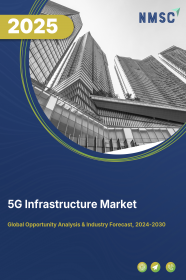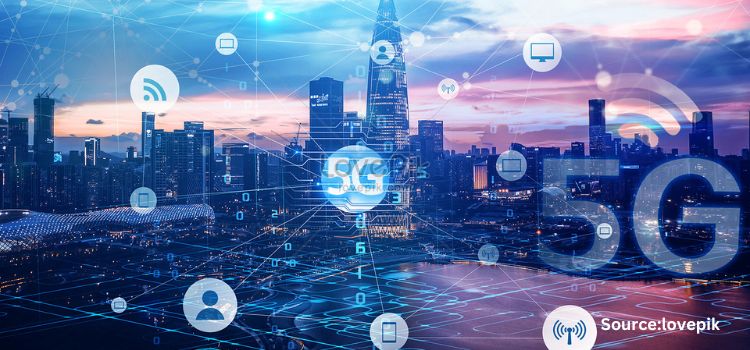
5G Infrastructure Market By Component (Hardware and Software), By Spectrum Band (Low Band (<1 GHz), Mid Band (1-6 GHz), and High Band (24-40 GHz)), by Technology (Radio Access Network (RAN), Core Network, Edge Computing, Cloud Infrastructure, Software-Defined Networking (SDN), and Network Function Virtualization (NFV)), and Others – Global Opportunity Analysis and Industry Forecast, 2025 – 2030
Industry: ICT & Media | Publish Date: 17-Feb-2025 | No of Pages: 682 | No. of Tables: 444 | No. of Figures: 389 | Format: PDF | Report Code : IC283
US Tariff Impact on 5G Infrastructure Market
Trump Tariffs Are Reshaping Global Business
5G Infrastructure Market Overview
The global 5G Infrastructure Market size was valued at USD 12.38 billion in 2024, and is predicted to reach USD 259.12 billion by 2030, with a CAGR of 66% from 2025 to 2030.
The 5G infrastructure market is a dynamic ecosystem of technologies, equipment, and services essential for deploying and operating 5G networks. It involves network equipment manufacturers, semiconductor companies, telecom operators, deployment service providers, edge computing and cloud service providers, regulatory bodies, and cybersecurity firms.
This market includes hardware components such as base stations, antennas, routers, and small cells, alongside software solutions for network management and virtualization. Chipmakers develop semiconductor components for high-speed data transmission in 5G devices, while telecom operators invest in infrastructure upgrades and spectrum licenses.
Deployment service providers offer installation and support, while edge computing and cloud providers deliver platforms for low-latency 5G applications. Regulatory bodies define deployment frameworks, and cybersecurity firms ensure network security. These elements drive innovation and growth in the 5G infrastructure market.
Increasing Data Traffic Fuels, the Demand for 5G Infrastructure
Factors influencing modern consumer behavior and technological advancements drive the surge in data traffic. Consumers, with the widespread use of smartphones, tablets, and connected devices, now anticipate seamless access to high-speed data services, rich multimedia content, and immersive experiences.
According to the Ericsson Mobility Report, during the third quarter of 2023, 163 million 5G subscriptions were added, resulting in a total of 1.4 billion subscriptions. This number is projected to surpass 5.3 billion by 2029. This surge in demand is further fueled by the rise of bandwidth-intensive applications such as video streaming platforms and online gaming, which require robust and low-latency connectivity for real-time experiences.
Emerging technologies such as augmented reality and virtual reality are increasingly integrated into various applications, driving the need for faster and more reliable connectivity. As such, the advent of 5G networks becomes crucial in meeting the escalating demands of digital consumers and enabling the seamless delivery of bandwidth-intensive content and applications.
Rising Government Emphasis Towards 5G Infrastructure Propels the Industry
Governments worldwide prioritize 5G infrastructure as a cornerstone of their digital agendas, driving economic growth, innovation, and global competitiveness. They offer subsidies, grants, and regulatory incentives to accelerate both private investment and adoption, removing financial barriers and fostering a favorable environment for 5G development. This strategic push aims to position nations at the forefront of the digital revolution, enabling industries to leverage 5G's potential for transformative breakthroughs across all sectors.
For instance, the Indian government’s spectrum auction in July 2022 and Jio’s acquisition of spectrum across low-band (700 MHz), mid-band (3.5 GHz) and high-band (26 GHz) have enabled rapid 5G expansion.
Moreover, the National Science Foundation (NSF) is investing USD 25 million to advance technologies and communications for secure operations via 5G networks. This initiative supports five NSF-funded teams selected for the NSF Convergence Accelerator Phase 2 program, focusing on developing 5G solutions. The NSF aims to address communication infrastructure challenges through this investment, promoting tangible outcomes for various sectors utilizing 5G networks.
Growing Utilization of 5G in the Healthcare Industry Boost the Market
The increasing adoption of 5G in healthcare is set to drive the 5G infrastructure market growth significantly. It enables telemedicine, remote patient monitoring, and real-time video consultations, improving healthcare accessibility. 5G facilitates Internet-connected medical devices for continuous monitoring, supports AR/VR applications for medical training, and empowers AI-driven healthcare solutions for better clinical outcomes.
Enhanced data security measures ensure the protection of sensitive health information, fostering trust among stakeholders. This integration of 5G technologies in healthcare promises to revolutionize patient care, enhance operational efficiency, and expand the market in the future. According to the report published by PwC, it is estimated that 5G-powered healthcare applications will add USD 530 billion to global GDP by 2030.
High Initial Investment Costs Associated with the 5G Infrastructure Restraint the Market
The deployment of 5G infrastructure poses significant financial challenges for telecom companies, especially in financially constrained regions. This includes building new infrastructure, upgrading networks, acquiring spectrum licenses, investing in R&D, and workforce development.
The extensive network construction, spectrum license acquisition, R&D investments, and workforce training all require substantial financial resources. Strategic planning, stakeholder collaboration, and innovative financing are crucial to overcome these barriers and expedite the adoption of 5G technology in the telecommunications sector.
Introduction of Emerging Technologies Creates Ample Opportunity
The emergence of technologies such as the Internet of Things (IoT) is rapidly expanding the network of interconnected devices, revolutionizing technology interactions across various domains. IoT devices, such as smart sensors, wearables, connected vehicles, and industrial machinery, generate vast amounts of data, necessitating robust connectivity solutions for large-scale data transmission with minimal latency.
5G networks, the backbone of the IoT revolution, offer high-speed connectivity and real-time data transmission. By leveraging 5G technology, IoT applications seamlessly transmit data between devices and cloud platforms, enabling rapid decision-making and dynamic interactions. This connectivity opens opportunities in smart cities, healthcare for remote monitoring and personalized treatment, agriculture for precision farming, and manufacturing/logistics for streamlined processes. The fusion of IoT and 5G drives innovation, digital transformation, and economic growth across sectors, reshaping how we engage with our surroundings.
North America is Projected to Dominate the 5G Infrastructure Market Share
The North America holds the predominant share in the 5G Infrastructure industry. This is attributed to the surge in the adoption of 5G technology in the Canada for cloud gaming and enhanced video usage in Canada. According to the Canadian Telecommunications Association, the projected economic influence of implementing 5G technology in Canada is expected to result in a USD 40 billion annual boost to the GDP by 2026, accompanied by the creation of 250,000 permanent jobs within the economy during the same period.
Moreover, the presence of prominent companies dedicatedly working towards bringing first private 5G network in Mexico which propels the growth of the 5G infrastructure market trends across the country. In 2024, AT&T and Ericsson launched a private 5G network at Tecnológico de Monterrey in Mexico for the advancement of Mexican technology and industry. Mexico's 1st private 5G network for robotics paves the way for industrial 5G adoption, boosting productivity, reducing emissions, and improving safety in manufacturing and mining.
In addition, the expansion of 5G Infrastructure in the U.S. healthcare sector shows imperative demand for the market thus paving a positive future. According to the Mckinsey, the healthcare sector profit pools will grow at a 4% CAGR from USD 654 billion in 2021 to USD 790 billion in 2026 signifies increased demand for healthcare services and technologies.
This growth is expected to drive investment in 5G infrastructure to support advanced healthcare solutions such as telemedicine and remote patient monitoring, thereby positively impacting the 5G industry by accelerating network deployment to meet healthcare sector needs.
Asia-Pacific to Witness Substantial Growth in the Market
Asia-Pacific is poised to witness the most rapid growth during the forecast period, fueled by the adoption of 5G in the telecom industry for fulfilling the rapidly growing demand for high-speed internet among the population. In 2023, SecurityGen announced to target Southeast Asia amidst the region's rapid 5G adoption, aiming to provide secure networks for operators in emerging 5G applications. Major telecom operators in Malaysia, Thailand, and Indonesia already rely on SecurityGen for mobile network security, showcasing its established presence and expertise in the region.
In addition, the rising investment in the 5G infrastructure is one of the crucial factors driving the 5G infrastructure market demand in this region. In 2023, Telecom operators announced to invest USD 259 billion in network infrastructure from 2023-2030, with a focus on 5G deployments. This investment is driven by rising data traffic, fueled by broadband adoption.
Furthermore, the growing emphasis towards the deployment of 5G for enterprises by the regional companies is fueling the adoption of 5G infrastructure market across the region. In 2024, Tech Mahindra, an Indian IT and consulting firm, partnered with Pegatron, a Taiwanese technology manufacturer, to develop private 5G solutions for enterprises. This collaboration aims to capitalize on Pegatron's diverse 5G product range and Tech Mahindra's expertise in global 5G for Enterprises (5G4E) rollout, jointly identifying opportunities worldwide.
Competitive Landscape
Various key players operating in the 5G Infrastructure industry include Huawei Technologies Co., Ltd., Ericsson, Nokia Corporation, Samsung Electronics Co., Ltd., Qualcomm Incorporated, Cisco Systems, Inc., LG Electronics Inc., ZTE Corporation, Intel Corporation, NEC Corporation, AT&T Inc., Dell Technologies, Microsoft Corporation, Hewlett Packard Enterprise (HPE), Oracle Corporation among others. These players are adopting strategies such as product launches across various regions to maintain their dominance in the market.
For instance, in February 2024, Qualcomm introduced the world's most advanced 5G Modem-RF System, incorporating integrated AI to drive the next generation of 5G technology. This cutting-edge system leverages AI to enhance 5G capabilities, marking a significant advancement in 5G technology.
Moreover, in February 2024, Huawei launched its Net5.5G solutions at MWC Barcelona 2024, focusing on ultra-broadband applications to drive carrier growth. These solutions support network evolution for carriers, emphasizing immersive terminals and AIGC for future network development. Huawei's initiative aims to inspire new growth in the telecom industry through advanced 5.5G technology.
In addition, in February 2024, ZTE launched 5G-A highlights at MWC 2024, showcasing groundbreaking advancements such as the industry's first NTN ground base station and innovative 5G IoT trials. These developments aim to enhance emergency communication, wide-area IoT, and internet services, emphasizing the integration of communication and computation for AI applications.
Furthermore, in February 2024, Nokia launched a new 5G mmWave receiver to enhance capacity in Fixed Wireless Access networks, aiming to bolster broadband coverage for urban areas and beyond. This innovation from Nokia in Espoo, Finland, underscores the company's commitment to advancing connectivity solutions for urban, suburban, and rural regions.
Also, in October 2023, Ericsson introduced a new software toolkit to empower telecom operators in delivering reliable and low-latency 5G networks, enabling premium services such as mobile cloud gaming and video conferencing. This innovative toolkit enhances network performance and supports differentiated experiences for various consumer and enterprise use cases, driving the evolution of 5G connectivity towards advanced applications and services.
5G Infrastructure Market Key Segments
By Component
-
Hardware
-
Software
By Spectrum Band
-
Low Band (<1 GHz)
-
Mid Band (1-6 GHz)
-
High Band (24-40 GHz)
By Technology
-
Radio Access Network (RAN)
-
Core Network
-
Edge Computing
-
Cloud Infrastructure
-
Software-Defined Networking (SDN)
-
Network Function Virtualization (NFV)
By Chipset Type
-
Application-Specific Integrated Circuit (ASIC)
-
Radio Frequency Integrated Circuit (RFIC)
-
Millimeter Wave Technology Chips
-
Field-Programmable Gate Array (FPGA))
By Application
-
Enhanced Mobile Broadband (eMBB)
-
Massive Machine-Type Communications (mMTC)
-
Ultra-Reliable Low-Latency Communications (URLLC)
-
Internet of Things (IoT)
-
Smart Cities
-
Connected Vehicles
-
Virtual & Augmented Reality (VR/AR)
-
Gaming & Entertainment
By End User
-
Telecom Operators
-
Enterprises
-
Government & Public Sector
-
Healthcare
-
Automotive
-
Manufacturing
-
Utilities
-
Transportation & Logistics
By Region
-
North America
-
The U.S.
-
Canada
-
Mexico
-
Europe
-
The UK
-
Germany
-
France
-
Italy
-
Spain
-
Denmark
-
Netherlands
-
Finland
-
Sweden
-
Norway
-
Russia
-
Rest of Europe
-
-
Asia-Pacific
-
China
-
Japan
-
India
-
South Korea
-
Australia
-
Indonesia
-
Singapore
-
Taiwan
-
Thailand
-
Rest of Asia-Pacific
-
-
Rest of World (RoW)
-
Latin America
-
Middle East
-
Africa
-
Key Players
-
Huawei Technologies Co., Ltd.
-
Ericsson
-
Nokia Corporation
-
Samsung Electronics Co., Ltd.
-
Qualcomm Incorporated
-
Cisco Systems, Inc.
-
LG Electronics Inc.
-
ZTE Corporation
-
Intel Corporation
-
NEC Corporation
-
AT&T Inc.
-
Dell Technologies
-
Microsoft Corporation
-
Hewlett Packard Enterprise (HPE)
-
Oracle Corporation
REPORT SCOPE AND SEGMENTATION:
| Parameters |
Details |
|
Market Size in 2024 |
USD 12.38 Billion |
|
Revenue Forecast in 2030 |
USD 259.12 Billion |
|
Growth Rate |
CAGR of 66.0% from 2025 to 2030 |
|
Analysis Period |
2024–2030 |
|
Base Year Considered |
2024 |
|
Forecast Period |
2025–2030 |
|
Market Size Estimation |
Billion (USD) |
|
Growth Factors |
|
|
Countries Covered |
28 |
|
Companies Profiled |
15 |
|
Market Share |
Available for 10 companies |
|
Customization Scope |
Free customization (equivalent to up to 80 working hours of analysts) after purchase. Addition or alteration to country, regional, and segment scope. |
|
Pricing and Purchase Options |
Avail customized purchase options to meet your exact research needs. |

















 Speak to Our Analyst
Speak to Our Analyst




















